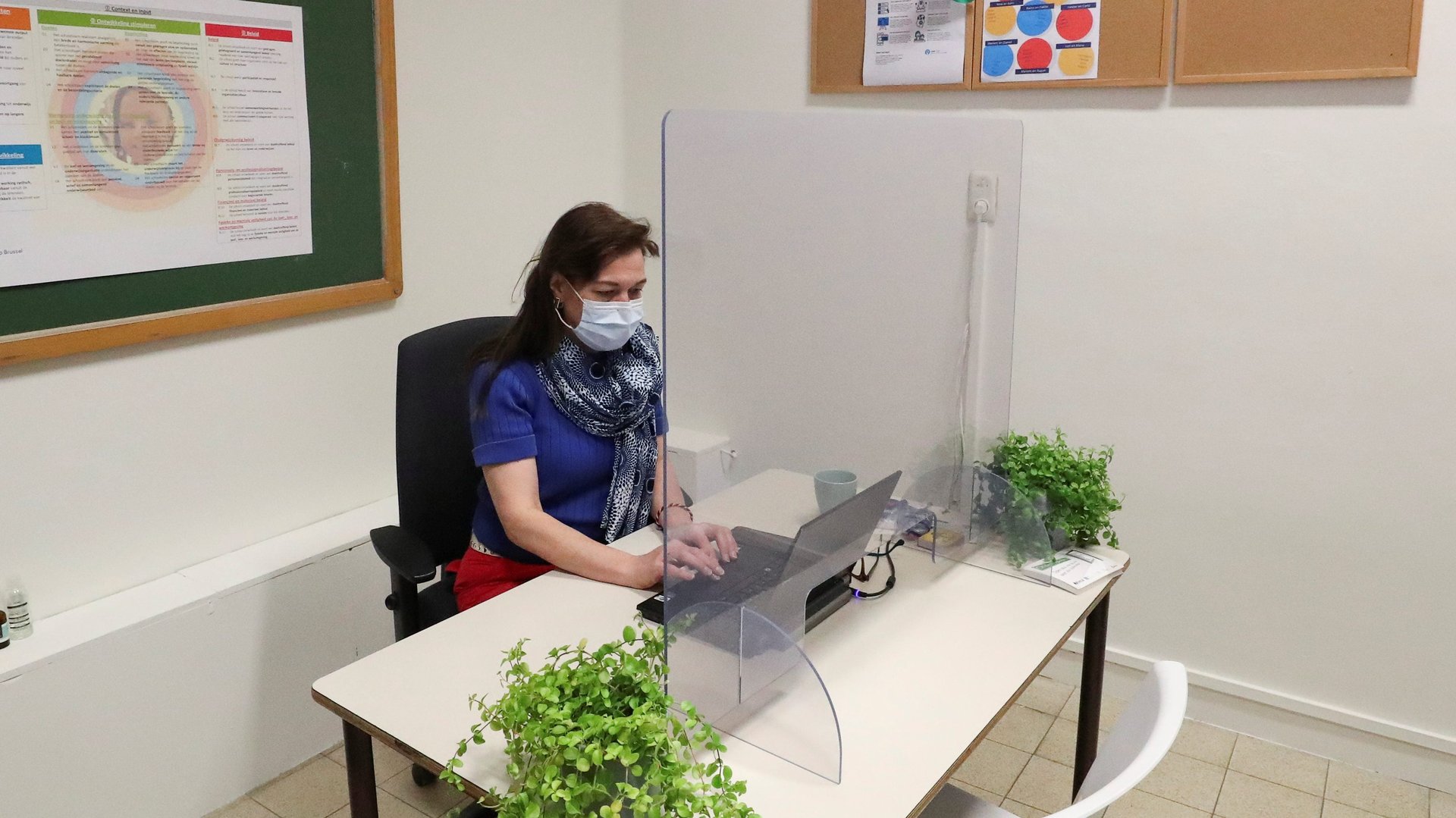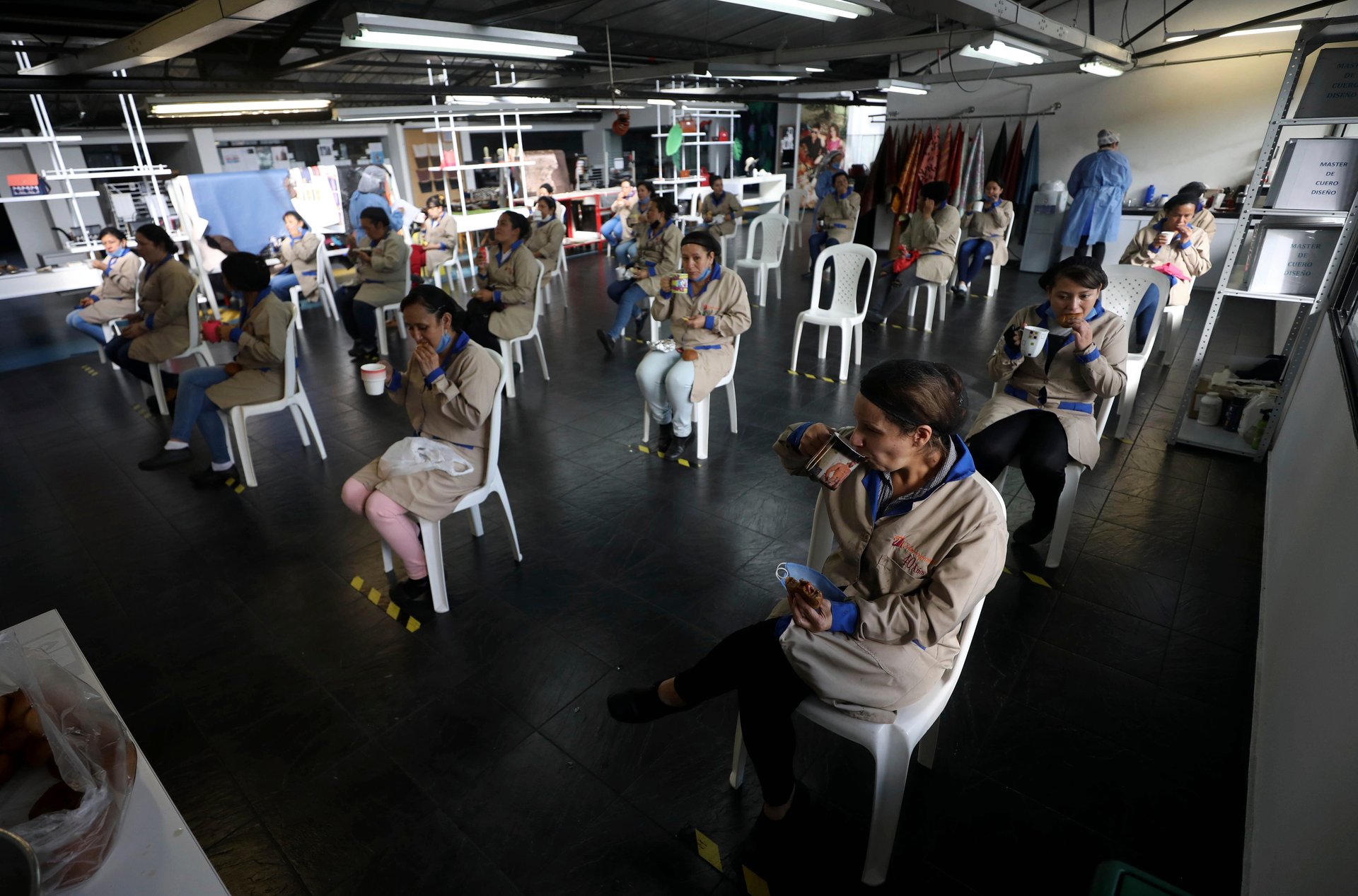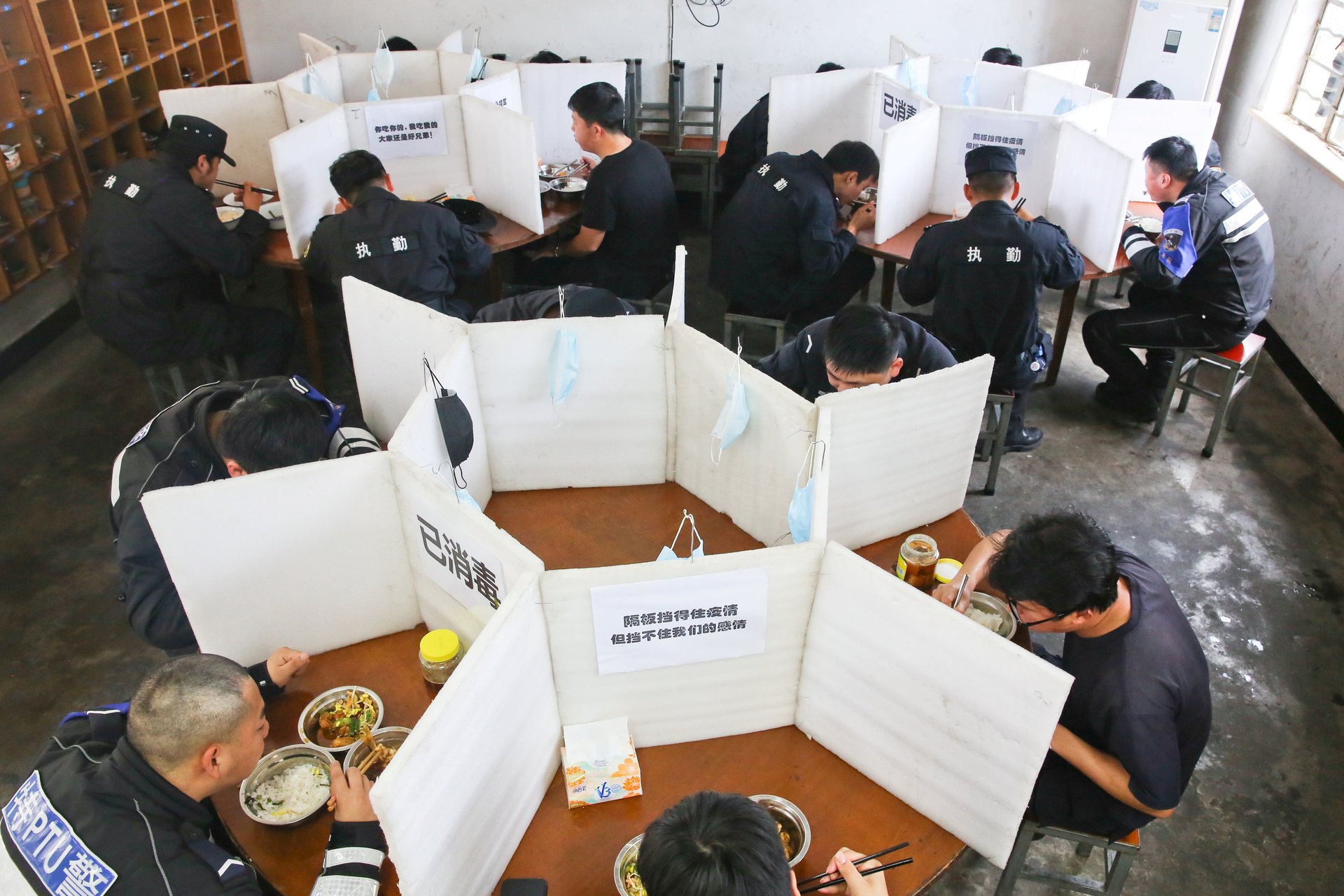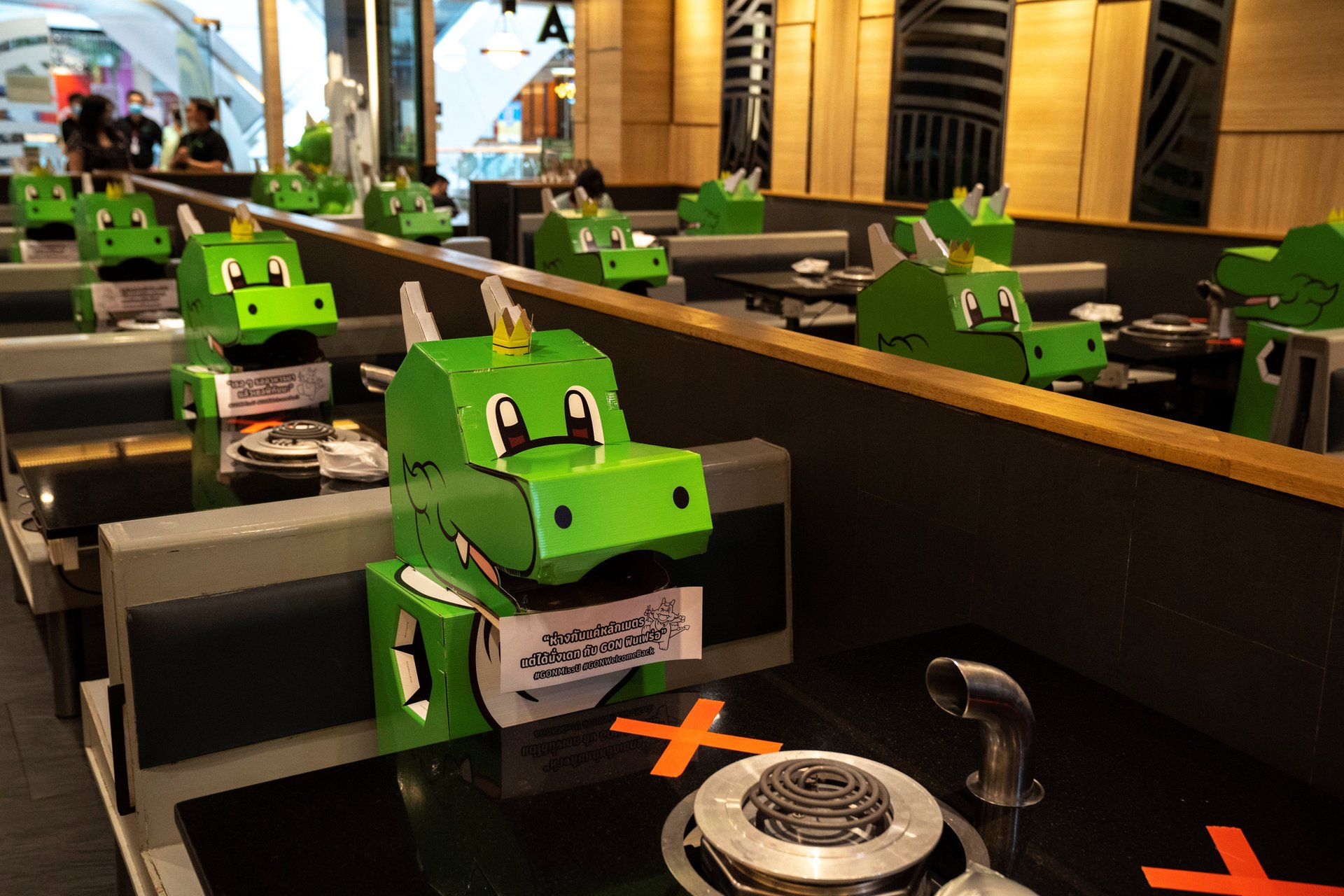We’re about to re-enter an office full of half-baked design prototypes
Forget the pristine, perfectly designed office. As businesses around the world begin to reopen, many workers will find a mess of masking tape, plastic sheets, police tape, floor decals, and a host of half-baked design solutions in the name stemming the spread of Covid-19.


Forget the pristine, perfectly designed office. As businesses around the world begin to reopen, many workers will find a mess of masking tape, plastic sheets, police tape, floor decals, and a host of half-baked design solutions in the name stemming the spread of Covid-19.
Plastics manufacturers are already advertising ready-to-ship coronavirus office solutions, from face shields to acrylic isolation booths and plexiglass cubicle partitions. Sneeze guards—transparent plastic sheets common in restaurant buffets—are in particularly high demand.
Last month, the commercial real estate firm Cushman & Wakefield introduced “The Six Feet Office,” a set of guidelines to help businesses reconfigure their workplace with social-distancing rules in mind. The concept includes unusual new practices such asking employees to use disposable desk placemats each day, or requiring everyone to only walk in a clockwise pattern around the office.
Businesses are still figuring out safety policies for communal toilets; the best ideas so far includes decommissioning urinals and stalls to give people a good berth. (Imagine the desperate queues.)
Office lunches are going to look very awkward.


Even eating out will be strange.

Most office solutions are prototypes, loose sketches that never would have been so quickly implemented in the absence of an emergency. Under normal circumstances, many of these makeshift, untested solutions would be deemed dangerous or even oppressive—literally barriers to work.
A hands-on crash course in industrial design
In many ways, the coronavirus has stoked DIY makers around the world. 3D printers for the home, once mostly used for churning out cute bric-a-brac, became machines for making critically needed PPE.
This enthusiasm is great, but it can be dangerous, too, warns Paolo Cardini, associate professor of industrial design at the Rhode Island School of Design. Most dabblers become obsessed with finessing beautiful objects and seldom think about its context or consequences.
Industrial designers, meanwhile, are in the business of “designing products, devices, objects and services used by millions of people around the world every day,” as the Industrial Designers Society of America puts it. They are concerned with aesthetics, engineering, and, most importantly, their inventions’ effects on the user.
More than any other time, the global pandemic has encouraged designers to tap into their resourcefulness, creative thinking, and MacGyver levels of inventiveness on a mass scale. In effect, we are in the midst of a hands-on crash course in industrial design, perhaps without even knowing it.
In the rush to respond to produce solutions, designers of all kinds may skip a crucial aspect of the industrial design development cycle, which has to do with testing prototypes.
In the typical cycle, a prototype goes through rounds of testing and tweaking. During this phase, designers refine form, ergonomics, safety, materials, and ease of manufacturing.
Thomas Edison famously tested thousands of models before arriving at an efficient design for the incandescent light bulb, for example. Though there are more advanced prototype technologies now, like 3D printing and CAD design software, this process can still take several years.
How can we balance speed with other factors?
It’s notable that even big companies are leaping to mass manufacturing of products for the Covid-19 era. Apple, for instance, began making 1 million plastic face shields before any consumer testing. Right in the assembly instructions, there is fine print stating that the “device has not been tested or qualified to prevent or reduce infection, and does not provide particulate filtration,” as Dezeen points out.
Cushman & Wakefield, too, has a disclaimer to the Six Feet Office, clarifying the firm is “not authorized or qualified to guide or influence” businesses in their reopening plans.
The history of industrial design is dotted with cautionary tales about manufacturers who compromised testing phase for speed, RISD’s Cardini notes. One explosive example is the Ford Pinto. In the late 1960s, the auto manufacturer rushed through the development of the car to compete with Japanese auto makers. Engineers erred in putting the gas tank too close to engine, which caused the car to explode in rear-end collisions. It’s the “best example of what happens when poor engineering meets corporate negligence,” according to Popular Mechanics.
A more recent example are office phone booths in open-plan offices. Last year, WeWork recalled thousands of units after elevated levels of formaldehyde were reported. Used in glues, formaldehyde is a substance linked to respiratory issues and cancers.
There is an oft-repeated industrial axiom that Cardini rejects: “fail fast, fail often.” Common among Silicon Valley startups, the principle involves making, and at times releasing, crappy first drafts into the world. “You are essentially asking people to be guinea pigs,” Cardini argues. “You are skipping safety prototyping and just hope that they’ll tell you what is wrong about the product. That’s dangerous.”
The Austrian designer Victor Papanek said that “there are professions more harmful than industrial design, but only a few,” Cardini notes, citing the opening passage of Papanek’s seminal 1971 book Design for the Real World.
Cardini, who has researched DIY culture, says the hands-on lessons in industrial design will foster greater appreciation for the technical details of making. “There will be better understanding of the products they buy, and a better understanding of how difficult it is to make the details work,” he explains. Even the act of following a sewing template for face masks will render lessons in material design. “Creativity is way more than a manual, it’s way more than a methodology,” he says.
But to learn industrial design’s most important lesson, one must also grapple with its myriad ethical concerns that help or harm the user and the planet. For one, there’s the sustainability aspect. “Any serious, responsible designer does a product life-cycle assessment,” explains Cardini. “What material are those masks are made of? Where they will end up being at the end of their cycle? We need to see products in a more holistic way.”
What office managers should do
Given the chaotic timelines and the limited inventory of clunky solutions, what is an office manager to do?
Cardini says it’s not the time to implement any permanent infrastructure or to order products in bulk. “I think we need to wait a little bit more to have a good array of effective and validated solutions,” he says.
It’s also important to consult experts who are attuned to the attributes of the virus.
The best solutions so far have come from health experts working with designers, policy makers, and users. For example, the architecture firm MASS Design has been working with with doctors dealing with pandemics and has published a useful set of guidelines (pdf) for designing healthier spaces. One particularly useful maxim: “Design for people, not just against pathogens. Well-intentioned spaces will fail if they clash with how people will actually use them. Designs need to respect user and cultural preferences and anticipate natural human behaviors.”
Cardini hopes to see more such collaborations between designers and health experts.
“The best things that we can do right now is operate in a more interdisciplinary manner,” Cardini says. “It could allow us to move faster and make less mistakes.”